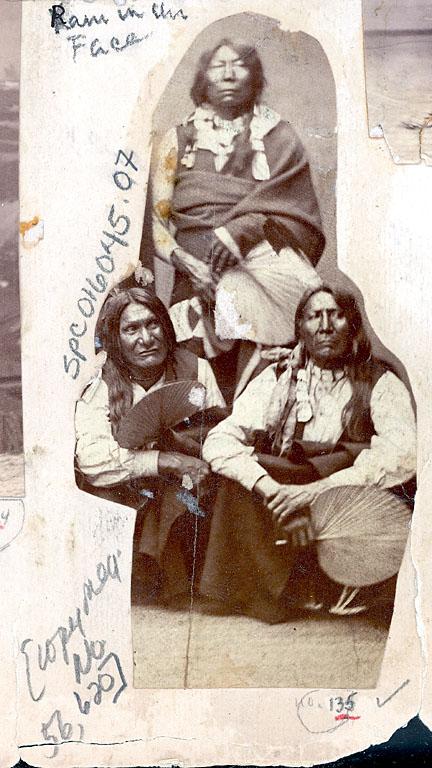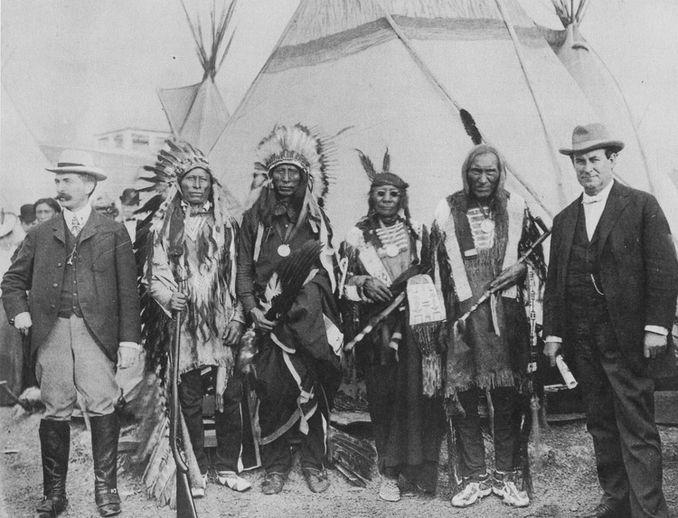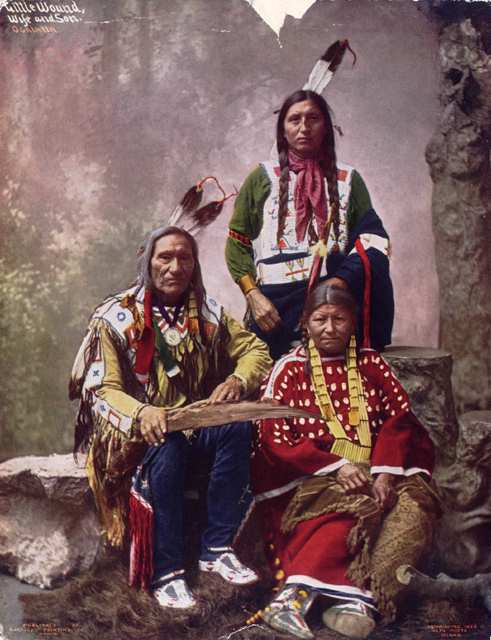|
|
Post by jinlian on Dec 22, 2008 17:29:45 GMT -5
According to Richard Hardoff, Little Wound ( Taopi Cikala), second son of the famous Kiyuksa chief Bull Bear, was born around 1828 in Wyoming, near the south fork of the Cheyenne River. After his father's killing (allegedly by a shot fired by Red Cloud during a drunken brawl) in 1841, Little Wound was raised by his elder brother Bull Bear jr. (b. 1825) and other elder members of his family, such as his uncle One Eye . After his brother's death in a fight with the Shoshone, Little Wound became itancan of the Kiyuksa. I don't know much about the band's activities in the 1850s and 1860s, except that they wandered in the area of the Republican for a while and then, after "living in the Fort Laramie area around the big-talking Bad Faces for 2 years" (1864-66), they moved to the South Platte area. In 1871, Little Wound settled at the Red Cloud Agency - according to some sources (Ostler and Goodyear who goes even farther talking of LW as a "friend" of Red Cloud), Red Cloud was somewhat instrumental in raising Little Wound's status among the agency chiefs. In the following years, Little Wound's position became more and more progressive to the eyes of US agents and officials (especially in the McGillycuddy years, when he was a staunch supporter of the agent). In the 1870-80 period, he joined various delegation to Washington, D.C. (1872, 1875, 1877 and 1880) . By the end of the 1880s, Little Wound shifted to an "anti-progressive" position when he opposed the Sioux bill proposed first by the Crook commission in 1888. He was however chosen once again as a delegate to Washington in the same year (while other chiefs who opposed the bill, as Red Cloud himself and Young Man Afraid were not). In 1890, despite having been a devote Episcopalian for many years, Little Wound became a Ghost Dancer (himself having a vision of the prophet and of the "other world") and his band joined for a while the "hostiles", returning to the agency only a while before Wounded Knee. In February 1891 he made another trip to Washington along with other Lakotas. He died in 1901, survived by his sons George and James and by a daughter who married Turning Hawk. Here are some photos of Little Wound:  (this is the "unidentified photograph" I spoke of in another thread - to me, the man kneeling on the left is obviously Little Wound)  1875 delegation - Little Wound is standing, last row, fifth from right  1877, by Mitchell  1877 delegation, by Bell sitting second from right  same as above, sitting second from left  same as above, standing second from left  same as above  detail of the 1877 Corcoran Gallery photo (sitting second from left)  1880 delegation by Bell (sitting, second from left) |
|
|
|
Post by jinlian on Dec 22, 2008 17:47:51 GMT -5
 1888 delegation, sitting third from left  1891, after Wounded Knee   1891, by Bell  1891 delgation, second row, sixth from left    1896, by Dinwiddie  Still 1896 by Dinwiddie, sitting first from left  As above, on the left    1899, by Rinehart  As above, with wife and son George  1901, by Arnold  Still by Arnold, 1901, at the Pan-Am (second from right) There are also some shots (group photos) posted by Grahame in the "Jack Red Cloud and friends" thread. It would be great to have more info and photos about Little Wound and, more generally, about the Bull Bear tiyospaye and the Kiyuksa band. |
|
|
|
Post by grahamew on Dec 23, 2008 5:20:54 GMT -5
I can't remember whether we posted this in the other thread or not - council, 1899:  Here's an undamaged version of the Arnold photo:  And a uncolourised version of the photo of LW and his family:  |
|
|
|
Post by grahamew on Dec 23, 2008 13:21:13 GMT -5
Little Wound by Burbank, 1898  |
|
|
|
Post by jinlian on Dec 23, 2008 13:50:26 GMT -5
A really impressive portrait! I knew Burbank had painted Little Wound, but never saw this work before. Thanks!
|
|
|
|
Post by Dietmar on Dec 23, 2008 16:09:26 GMT -5
Yeah, wonderful paintings.
I´m still puzzled about the first photo in this thread. I wouldn´t have recognized Little Wound, even after studying the picture since years.
If it is Little Wound, it is possibly the earliest portrait of him. Where have you seen that he was part of the 1872 delegation, Jinlian?
|
|
|
|
Post by jinlian on Dec 23, 2008 16:21:38 GMT -5
Hi Dietmar, James Olson, in his Red Cloud and the Sioux Problem reports that Little Wound was indeed in the 1872 delegation to Washington - his sources are the reports of the Secretary of the Interior and newspapers accounts such as those of the New York Times and the Cheyenne Daily Leader. Catherine Price, in The Oglala People confirms that Little Wound was a delegate to Washington in 1872. Olson has some the 1872 Oglala delegates as follows: Red Cloud, Red Dog, High Wolf, Little Wound, Red Leaf, Big Foot, Blue Horse. Interpreters were Jules Ecoffey, Nick Janis and Joseph Bissonette. Personally, in the very moment I saw this photograph I thought "This is Little Wound!"...of course, as every opinion, it is subjective...but for sure, this man isn't Two Strike.  By the way, this is the link to the NY Times article mentioning many of the 1872 delegation members - Little Wound is mentioned right after Red Cloud and Red Dog: query.nytimes.com/mem/archive-free/pdf?_r=1&res=9D01E1D6113EEE34BC4851DFB3668389669FDE |
|
|
|
Post by jinlian on Dec 23, 2008 17:26:45 GMT -5
Little Wound remembered by Elbridge Burbank:
"Chief Little Wound was said to have more influence over the Sioux than any other living Indian. His father had been killed by Chief Red Cloud. Both Little Wound and Red Cloud sat for me in the same room, though at different times, of course.
Little Wound posed for me in full war dress, wearing a silver medal given to him by President Grant, and his portrait attracted great attention. He was held in great esteem by the white people who considered him a dependable Indian, and at the same time he was much beloved by his own people.
One day I went in to Yellow Bird's store at Pine Ridge and discovered the place crowded with Indians crying and wailing and wringing their hands. They told me that Little Wound was dead. He had gone to Omaha and, getting off the white man's street car, he had fallen backwards striking his head on the pavement."
|
|
|
|
Post by grahamew on Jan 11, 2009 13:21:37 GMT -5
Little Wound's camp, post Wounded Knee, by Trager - or that's what it's purported to be. You can never be sure with Trager:  |
|
|
|
Post by jinlian on Jan 16, 2009 10:02:13 GMT -5
Thank you, Grahame. A close-up from one of the 1877 delegation photographs:  |
|
|
|
Post by jinlian on Jan 16, 2009 17:29:48 GMT -5
Found on ebay, no clue about the photographer (Arnold?):  |
|
|
|
Post by jinlian on Jan 28, 2010 13:18:30 GMT -5
Little Wound, 1872, photographed by A. Gardner (from the W. Blackmore collection, British Museum) :  |
|
|
|
Post by Dietmar on Mar 30, 2012 8:10:20 GMT -5
|
|
|
|
Post by Dietmar on Apr 19, 2012 11:14:20 GMT -5
from "Voices of the American West, Volume 1 - The Indian Interviews of Eli S. Ricker, 1903-1919", University of Nebraska Press, page 140/141:
"Little Wound, an Ogallala Sioux Chief, is now (March, 1896) 68 years of age. In 1844, when at the age of 16, his father took him on the war path gainst the Shoshone Indians. He killed his man in a singlehanded fight and was badly wounded himself. As it was customary among the Indians, when a warrior done (sic) any deeds of bravery in battle to give him a new name. He was named ‘‘Little Wound,’’ from the fact he was small and doing such a deed of bravery. His former name being ‘‘Good Singer’’ when a boy.
He was engaged in numberless battles and skirmishes (with Indians) who were at war with the Sioux, and in many instances killed enemies, from which he became distinguished.
Sometime in 1860 some white people were trying to induce the Indians to live in peace with one another, and Little Wound agreed to live in peace if the other tribes would not molest him. That he would only fight in self-defense.
The Omaha warriors attacked his people, and he, with his warriors, chased them home and killed about 100 of them. He then sent word around to the neighboring tribes that he did not want to fight any more, and asked them not to force him into any more fights. But the Pawnees took advantage of his band when all the men folks were out on a buffalo chase, and took the camp where only women and children were. They killed something over 100 of his band, women, children and old men who were in camp. Shortly after that occurred, the head chief of the Pawnee Indians sent him a ‘‘Pipe of Peace.’’ He rejected the ‘‘Pipe of Peace’’ and said ‘‘No, my wounds are too sore yet: the wounds that you gave me are not healed up.’’ In reply the Pawnee chief insisted on peace, and offered to pay damages in horses. Little Wound also rejected that and in reply sent to the Pawnee chief arrows, returning the ‘‘Pipe of Peace,’’ meaning a dec-
laration of war, and also said, ‘‘You took advantage of me when all the men folks were away, and killed our women and children. I now notify you to make ready, and make as many arrows as you can and have them all ready, for I am coming to punish fight, for I will not sneak on and take advantage of you as you did me.’’
When the appointed time came he went with his warriors and attacked the Pawnee tribe, and as his were the bravest and most dreaded warriors of the Sioux tribe, after meeting in battle, they in a very short time defeated the Pawnees and killed over 200 of their number and chased the others away. He also captured from the camp a number of women and children.
It was a known practice among the Indians that Indian prisoners of war expected no mercy from their captors, but on the contrary immediate death or other inhuman treatment. Little Wound gathered all the women and children prisoners together. ‘‘I will not do as my women and children were done by your husbands: they beat my women and children and made slaves of them; but in return for that I am going to paint your faces red (a work of kindness and respect), dress you in my women’s clothes, and will furnish you with good horses so that you can [go] back to your cowardly husbands,’’ and he did as he said he would, sending Antoine Janis, a well known character in charge of them to the Pawnee tribe.
The following year the Pawnees, with some of the head chiefs, came to the Ogallala camp and demanded damages, when Little Wound replied to them: ‘‘After I asked you people to let me alone, and let me live in peace, you came to my camp and murdered my women and children while my men folks were on a buffalo chase, and I never cried, or begged any one to help me get pay; but I came and punished you, captured your women and children, and when I heard them cry I took mercy on them, painted their faces red, put them on good horses and sent them back to you. So, if you want pay, get your warriors together, your bows and arrows, and take pay out of me.’’ Nothing further was said about it. This was his last fight, and from that day to this he has lived at peace with the Indian tribes and the whites."
|
|
|
|
Post by Dietmar on Apr 19, 2012 11:25:14 GMT -5
on page 6 in the same book (William Garnett interview):
"The government was desirous to move the Cutoffs from the Republican and the lower Platte off from the line of overland travel, and assemble the Oglalas together; so Red Cloud was advised to make Little Wound, the son of Bull Bear, a chief of his band as a reparation for the killing of Bull Bear; and Red Cloud had been in Washington in 1870 and this scheme had been worked on him as a device agreeable both to the government and himself; so in 1871 there was a big council held near Fort Laramie, and in the transaction of business Little Wound, on the politic suggestion of Red Cloud, was made a chief to succeed Bull Bear, and from that date they had their headquarters with the rest of the Oglalas."
|
|













































